Chapter 17: Cognitive Development in Middle Childhood
Chapter 17 Learning Objectives
- Describe Piaget’s concrete operational stage and the characteristics of concrete thought
- Describe information processing research on memory, attention, knowledgebase, metacognition, and critical thinking
- Describe language development and explain the three types of communication disorders
- Describe the theories of intelligence, including general “g”, triarchic theory, and Gardner’s multiple intelligences
- Explain how intelligence is measured, the tests used to assess intelligence, the extremes in intelligence, and the concern of bias
- Describe how language and culture influence the typical classroom
- Identify common disabilities in childhood and the legislation that protects them educationally
Recall from the last chapter that children in early childhood are in Piaget’s preoperational stage, and during this stage, children are learning to think symbolically about the world. Cognitive skills continue to expand in middle and late childhood as thought processes become more logical and organized when dealing with concrete information. Children at this age understand concepts such as past, present, and future, giving them the ability to plan and work toward goals. Additionally, they can process complex ideas such as addition and subtraction and cause-and-effect relationships.
Concrete Operational Thought
From ages 7 to 11, children are in what Piaget referred to as the concrete operational stage of cognitive development (Crain, 2005). This involves mastering the use of logic in concrete ways. The word concrete refers to that which is tangible; that which can be seen, touched or experienced directly. The concrete operational child is able to make use of logical principles in solving problems involving the physical world. For example, the child can understand the principles of cause and effect, size, and distance.
The child can use logic to solve problems tied to their own direct experience but has trouble solving hypothetical problems or considering more abstract problems. The child uses inductive reasoning, which is a logical process in which multiple premises believed to be true are combined to obtain a specific conclusion. For example, a child has one friend who is rude, another friend who is also rude, and the same is true for a third friend. The child may conclude that friends are rude. We will see that this way of thinking tends to change during adolescence being replaced with deductive reasoning. We will now explore some of the major abilities that the concrete child exhibits.
Classification: As children’s experiences and vocabularies grow, they build schemata and are able to organize objects in many different ways. They also understand classification hierarchies and can arrange objects into a variety of classes and subclasses.
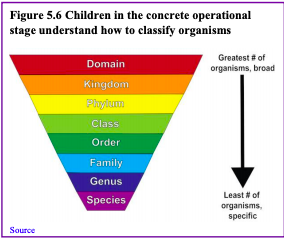
Identity: One feature of concrete operational thought is the understanding that objects have qualities that do not change even if the object is altered in some way. For instance, the mass of an object does not change by rearranging it. A piece of chalk is still chalked even when the piece is broken in two.
Reversibility: The child learns that some things that have been changed can be returned to their original state. Water can be frozen and then thawed to become liquid again, but eggs cannot be unscrambled. Arithmetic operations are reversible as well: 2 + 3 = 5 and 5 – 3 = 2. Many of these cognitive skills are incorporated into the school’s curriculum through mathematical problems and in worksheets about which situations are reversible or irreversible.
Conservation: Remember the example in our last chapter of preoperational children thinking that a tall beaker filled with 8 ounces of water was “more” than a short, wide bowl filled with 8 ounces of water? Concrete operational children can understand the concept of conservation which means that changing one quality (in this example, height or water level) can be compensated for by changes in another quality (width). Consequently, there is the same amount of water in each container, although one is taller and narrower and the other is shorter and wider.
Decentration: Concrete operational children no longer focus on only one dimension of any object (such as the height of the glass) and instead consider the changes in other dimensions too (such as the width of the glass). This allows for conservation to occur.
Seriation: Arranging items along a quantitative dimension, such as length or weight, in a methodical way is now demonstrated by the concrete operational child. For example, they can methodically arrange a series of different-sized sticks in order by length, while younger children approach a similar task in a haphazard way.
These new cognitive skills increase the child’s understanding of the physical world, however according to Piaget, they still cannot think in abstract ways. Additionally, they do not think in systematic scientific ways. For example, when asked which variables influence the period that a pendulum takes to complete its arc and given weights they can attach to strings in order to do experiments, most children younger than 12 perform biased experiments from which no conclusions can be drawn (Inhelder & Piaget, 1958).
Information Processing
Children differ in their memory abilities, and these differences predict both their readiness for school and academic performance in school (PreBler, Krajewski, & Hasselhorn, 2013). During middle and late childhood children make strides in several areas of cognitive function including the capacity of working memory, their ability to pay attention, and their use of memory strategies. Both changes in the brain and experience foster these abilities.
Working Memory: The capacity of working memory expands during middle and late childhood, and research has suggested that both an increase in processing speed and the ability to inhibit irrelevant information from entering memory are contributing to the greater efficiency of working memory during this age (de Ribaupierre, 2002). Changes in myelination and synaptic pruning in the cortex are likely behind the increase in processing speed and ability to filter out irrelevant stimuli (Kail, McBride-Chang, Ferrer, Cho, & Shu, 2013).
Children with learning disabilities in math and reading often have difficulties with working memory (Alloway, 2009). They may struggle with following the directions of an assignment. When a task calls for multiple steps, children with poor working memory may miss steps because they may lose track of where they are in the task. Adults working with such children may need to communicate: Using more familiar vocabulary, using shorter sentences, repeating task instructions more frequently, and breaking more complex tasks into smaller more manageable steps. Some studies have also shown that more intensive training of working memory strategies, such as chunking, aid in improving the capacity of working memory in children with poor working memory (Alloway, Bibile, & Lau, 2013).
Attention: As noted above, the ability to inhibit irrelevant information improves during this age group, with there being a sharp improvement in selective attention from age six into adolescence (Vakil, Blachstein, Sheinman, & Greenstein, 2009). Children also improve in their ability to shift their attention between tasks or different features of a task (Carlson, Zelazo, & Faja, 2013). A younger child who is asked to sort objects into piles based on type of object, car versus animal, or color of object, red versus blue, may have difficulty if you switch from asking them to sort based on type to now having them sort based on color. This requires them to suppress the prior sorting rule. An older child has less difficulty making the switch, meaning there is greater flexibility in their attentional skills. These changes in attention and working memory contribute to children having more strategic approaches to challenging tasks.
Memory Strategies: Bjorklund (2005) describes a developmental progression in the acquisition and use of memory strategies. Such strategies are often lacking in younger children but increase in frequency as children progress through elementary school. Examples of memory strategies include rehearsing information you wish to recall, visualizing and organizing information, creating rhymes, such “i” before “e” except after “c”, or inventing acronyms, such as “roygbiv” to remember the colors of the rainbow. Schneider, Kron-Sperl, and Hünnerkopf (2009) reported a steady increase in the use of memory strategies from ages six to ten in their longitudinal study (see Table 5.2). Moreover, by age ten many children were using two or more memory strategies to help them recall information. Schneider and colleagues found that there were considerable individual differences at each age in the use of strategies, and that children who utilized more strategies had better memory performance than their same aged peers.
Children may experience three deficiencies in their use of memory strategies. A mediation deficiency occurs when a child does not grasp the strategy being taught, and thus, does not benefit from its use.
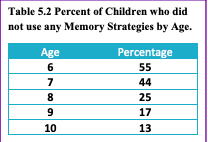
If you do not understand why using an acronym might be helpful, or how to create an acronym, the strategy is not likely to help you. In a production deficiency the child does not spontaneously use a memory strategy and must be prompted to do so. In this case, children know the strategy and are more than capable of using it, but they fail to “produce” the strategy on their own. For example, children might know how to make a list, but may fail to do this to help them remember what to bring on a family vacation. A utilization deficiency refers to children using an appropriate strategy, but it fails to aid their performance. Utilization deficiency is common in the early stages of learning a new memory strategy (Schneider & Pressley, 1997; Miller, 2000). Until the use of the strategy becomes automatic it may slow down the learning process, as space is taken up in memory by the strategy itself. Initially, children may get frustrated because their memory performance may seem worse when they try to use the new strategy. Once children become more adept at using the strategy, their memory performance will improve. Sodian and Schneider (1999) found that new memory strategies acquired prior to age eight often show utilization deficiencies with there being a gradual improvement in the child’s use of the strategy. In contrast, strategies acquired after this age often followed an “all-or-nothing” principle in which improvement was not gradual, but abrupt.
Knowledge Base: During middle and late childhood, children are able to learn and remember due to an improvement in the ways they attend to and store information. As children enter school and learn more about the world, they develop more categories for concepts and learn more efficient strategies for storing and retrieving information. One significant reason is that they continue to have more experiences on which to tie new information. In other words, their knowledge base, knowledge in particular areas that makes learning new information easier, expands (Berger, 2014).
Metacognition: Children in middle and late childhood also have a better understanding of how well they are performing a task, and the level of difficulty of a task. As they become more realistic about their abilities, they can adapt studying strategies to meet those needs. Young children spend as much time on an unimportant aspect of a problem as they do on the main point, while older children start to learn to prioritize and gauge what is significant and what is not. As a result, they develop metacognition. Metacognition refers to the knowledge we have about our own thinking and our ability to use this awareness to regulate our own cognitive processes (Bruning, Schraw, Norby, & Ronning, 2004).
Critical Thinking: According to Bruning et al. (2004) there is a debate in U.S. education as to whether schools should teach students what to think or how to think. Critical thinking, or a detailed examination of beliefs, courses of action, and evidence, involves teaching children how to think. The purpose of critical thinking is to evaluate information in ways that help us make informed decisions. Critical thinking involves better understanding a problem through gathering, evaluating, and selecting information, and also by considering many possible solutions. Ennis (1987) identified several skills useful in critical thinking. These include: Analyzing arguments, clarifying information, judging the credibility of a source, making value judgements, and deciding on an action. Metacognition is essential to critical thinking because it allows us to reflect on the information as we make decisions.
Language Development
Vocabulary: One of the reasons that children can classify objects in so many ways is that they have acquired a vocabulary to do so. By fifth grade, a child’s vocabulary has grown to 40,000 words. It grows at a rate that exceeds that of those in early childhood. This language explosion, however, differs from that of younger children because it is facilitated by being able to associate new words with those already known, and because it is accompanied by a more sophisticated understanding of the meanings of a word.
New Understanding: Those in middle and late childhood are also able to think of objects in less literal ways. For example, if asked for the first word that comes to mind when one hears the word “pizza”, the younger child is likely to say “eat” or some word that describes what is done with a pizza. However, the older child is more likely to place pizza in the appropriate category and say “food”. This sophistication of vocabulary is also evidenced by the fact that older children tell jokes and delight in doing do. They may use jokes that involve plays on words such as “knock- knock” jokes or jokes with punch lines. Young children do not understand play on words and tell “jokes” that are literal or slapstick, such as “A man fell down in the mud! Isn’t that funny?”
Grammar and Flexibility: Older children are also able to learn new rules of grammar with more flexibility. While younger children are likely to be reluctant to give up saying “I goed there”, older children will learn this rather quickly along with other rules of grammar.
Communication Disorders
At the end of early childhood, children are often assessed in terms of their ability to speak properly. By first grade, about 5% of children have a notable speech disorder (Medline Plus, 2016c).
Fluency disorders: Fluency disorders affect the rate of speech. Speech may be labored and slow, or too fast for listeners to follow. The most common fluency disorder is stuttering.
Stuttering is a speech disorder in which sounds, syllables, or words are repeated or last longer than normal. These problems cause a break in the flow of speech, which is called dysfluency (Medline Plus, 2016b). About 5% of young children, aged two-five, will develop some stuttering that may last from several weeks to several years (Medline Plus, 2016c).
Approximately 75% of children recover from stuttering. For the remaining 25%, stuttering can persist as a lifelong communication disorder (National Institute on Deafness and other Communication Disorders, NIDCD, 2016). This is called developmental stuttering and is the most common form of stuttering. Brain injury, and in very rare instances, emotional trauma may be other triggers for developing problems with stuttering. In most cases of developmental stuttering, other family members share the same communication disorder. Researchers have recently identified variants in four genes that are more commonly found in those who stutter (NIDCD, 2016).
Articulation disorder: An articulation disorder refers to the inability to correctly produce speech sounds (phonemes) because of imprecise placement, timing, pressure, speed, or flow of movement of the lips, tongue, or throat (NIDCD, 2016). Sounds can be substituted, left off, added or changed. These errors may make it hard for people to understand the speaker. They can range from problems with specific sounds, such as lisping to severe impairment in the phonological system. Most children have problems pronouncing words early on while their speech is developing. However, by age three, at least half of what a child says should be understood by a stranger. By age five, a child’s speech should be mostly intelligible. Parents should seek help if by age six the child is still having trouble producing certain sounds. It should be noted that accents are not articulation disorders (Medline Plus, 2016a).
Voice disorders: Disorders of the voice involve problems with pitch, loudness, and quality of the voice (American Speech-Language and Hearing Association, 2016). It only becomes a disorder when problems with the voice makes the child unintelligible. In children, voice disorders are significantly more prevalent in males than in females. Between 1.4% and 6% of children experience problems with the quality of their voice. Causes can be due to structural abnormalities in the vocal cords and/or larynx, functional factors, such as vocal fatigue from overuse, and in rarer cases psychological factors, such as chronic stress and anxiety.
Theories of Intelligence
Psychologists have long debated how to best conceptualize and measure intelligence (Sternberg, 2003). These questions include: How many types of intelligence are there, the role of nature versus nurture in intelligence, how intelligence is represented in the brain, and the meaning of group differences in intelligence.

General (g) versus Specific (s) Intelligences: From 1904-1905 the French psychologist Alfred Binet (1857–1914) and his colleague Théodore Simon (1872–1961) began working on behalf of the French government to develop a measure that would identify children who would not be successful with the regular school curriculum. The goal was to help teachers better educate these students (Aiken, 1994). Binet and Simon developed what most psychologists today regard as the first intelligence test, which consisted of a wide variety of questions that included the ability to name objects, define words, draw pictures, complete sentences, compare items, and construct sentences.
Binet and Simon (Binet, Simon, & Town, 1915; Siegler, 1992) believed that the questions they asked the children all assessed the basic abilities to understand, reason, and make judgments. It turned out that the correlations among these different types of measures were in fact all positive; that is, students who got one item correct were more likely to also get other items correct, even though the questions themselves were very different.
On the basis of these results, the psychologist Charles Spearman (1863–1945) hypothesized that there must be a single underlying construct that all of these items measure. He called the construct that the different abilities and skills measured on intelligence tests have in common the General Intelligence Factor (g). Virtually all psychologists now believe that there is a generalized intelligence factor, “g”, that relates to abstract thinking and that includes the abilities to acquire knowledge, to reason abstractly, to adapt to novel situations, and to benefit from instruction and experience (Gottfredson, 1997; Sternberg, 2003). People with higher general intelligence learn faster.
Soon after Binet and Simon introduced their test, the American psychologist Lewis Terman at Stanford University (1877–1956) developed an American version of Binet’s test that became known as the Stanford-Binet Intelligence Test. The Stanford- Binet is a measure of general intelligence made up of a wide variety of tasks, including vocabulary, memory for pictures, naming of familiar objects, repeating sentences, and following commands.

Although there is general agreement among psychologists that “g” exists, there is also evidence for specific intelligence “s”, a measure of specific skills in narrow domains. One empirical result in support of the idea of “s” comes from intelligence tests themselves. Although the different types of questions do correlate with each other, some items correlate more highly with each other than do other items; they form clusters or clumps of intelligence.
Triarchic Theory: One advocate of the idea of multiple intelligences is the psychologist Robert Sternberg. Sternberg has proposed a triarchic (three-part) theory of intelligence that proposes that people may display more or less analytical intelligence, creative intelligence, and practical intelligence. Sternberg (1985, 2003) argued that traditional intelligence tests assess analytical intelligence, academic problem solving and performing calculations, but that they do not typically assess creative intelligence, the ability to adapt to new situations and create new ideas, and/or practical intelligence, the ability to demonstrate common sense and street-smarts.
As Sternberg proposed, research has found that creativity is not highly correlated with analytical intelligence (Furnham & Bachtiar, 2008) and exceptionally creative scientists, artists, mathematicians, and engineers do not score higher on intelligence than do their less, creative peers (Simonton, 2000).

Furthermore, the brain areas that are associated with convergent thinking, thinking that is directed toward finding the correct answer to a given problem, are different from those associated with divergent thinking, the ability to generate many different ideas or solutions to a single problem (Tarasova, Volf, & Razoumnikova, 2010). On the other hand, being creative often takes some of the basic abilities measured by “g”, including the abilities to learn from experience, to remember information, and to think abstractly (Bink & Marsh, 2000). Ericsson (1998), Weisberg (2006), Hennessey and Amabile (2010) and Simonton (1992) studied creative people and identified at least five components that are likely to be important for creativity as listed in Table 5.3
Table 5.3

The last aspect of the triarchic model, practical intelligence, refers primarily to intelligence that cannot be gained from books or formal learning. Practical intelligence represents a type of “street smarts” or “common sense” that is learned from life experiences. Although a number of tests have been devised to measure practical intelligence (Sternberg, Wagner, & Okagaki, 1993; Wagner & Sternberg, 1985), research has not found much evidence that practical intelligence is distinct from “g” or that it is predictive of success at any particular tasks (Gottfredson, 2003).
Practical intelligence may include, at least in part, certain abilities that help people perform well at specific jobs, and these abilities may not always be highly correlated with general intelligence (Sternberg et al., 1993).
Theory of Multiple Intelligences: Another champion of the idea of specific types of intelligences rather than one overall intelligence is the psychologist Howard Gardner (1983, 1999). Gardner argued that it would be evolutionarily functional for different people to have different talents and skills and proposed that there are eight intelligences that can be differentiated from each other. A potential ninth intelligence; that is, existential still needs empirical support. Gardner investigated intelligences by focusing on children who were talented in one or more areas and adults who suffered from strokes that compromised some capacities, but not others. Gardner also noted that some evidence for multiple intelligences comes from the abilities of autistic savants, people who score low on intelligence tests overall, but who nevertheless may have exceptional skills in a given domain, such as math, music, art, or in being able to recite statistics in a given sport (Treffert & Wallace, 2004). In addition to brain damage and the existence of savants, Gardner identified these 8 intelligences based on other criteria including a set developmental history and psychometric findings. See Table 5.4 for a list of Gardner’s eight specific intelligences.
|
Table 5.4 Howard Gardner’s Eight Specific Intelligences |
|
|
Intelligence |
Description |
|
Linguistic |
The ability to speak and write well |
|
Logical-mathematical |
The ability to use logic and mathematical skills to solve problems |
|
Spatial |
The ability to think and reason about objects in three dimensions |
|
Musical |
The ability to perform and enjoy music |
|
Kinesthetic (body) |
The ability to move the body in sports, dance, or other physical activities |
|
Interpersonal |
The ability to understand and interact effectively with others |
|
Intrapersonal |
The ability to have insight into the self |
|
Naturalistic |
The ability to recognize, identify, and understand animals, plants, and other living things |
|
Source: Adapted from Gardner, H. (1999). Intelligence reframed: Multiple intelligences for the 21st century. New York, NY: Basic Books. |
Table 5.4
The idea of multiple intelligences has been influential in the field of education, and teachers have used these ideas to try to teach differently to different students. For instance, to teach math problems to students who have particularly good kinesthetic intelligence, a teacher might encourage the students to move their bodies or hands according to the numbers. On the other hand, some have argued that these “intelligences” sometimes seem more like “abilities” or “talents” rather than real intelligence. There is no clear conclusion about how many intelligences there are. Are sense of humor, artistic skills, dramatic skills, and so forth also separate intelligences? Furthermore, and again demonstrating the underlying power of a single intelligence, the many different intelligences are, in fact, correlated and thus represent, in part, “g” (Brody, 2003).

Measuring Intelligence: Standardization and the Intelligence Quotient
The goal of most intelligence tests is to measure “g”, the general intelligence factor. Good intelligence tests are reliable, meaning that they are consistent over time, and also demonstrate validity, meaning that they actually measure intelligence rather than something else. Because intelligence is such an important individual difference dimension, psychologists have invested substantial effort in creating and improving measures of intelligence, and these tests are now considered the most accurate of all psychological tests. In fact, the ability to accurately assess intelligence is one of the most important contributions of psychology to everyday public life.
Intelligence changes with age. A 3-year-old who could accurately multiply 183 by 39 would certainly be intelligent, but a 25-year-old who could not do so would be seen as unintelligent. Thus, understanding intelligence requires that we know the norms or standards in a given population of people at a given age. The standardization of a test involves giving it to a large number of people at different ages and computing the average score on the test at each age level.
It is important that intelligence tests be standardized on a regular basis, because the overall level of intelligence in a population may change over time. The Flynn effect refers to the observation that scores on intelligence tests worldwide have increased substantially over the past decades (Flynn, 1999). Although the increase varies somewhat from country to country, the average increase is about 3 IQ points every 10 years. There are many explanations for the Flynn effect, including better nutrition, increased access to information, and more familiarity with multiple-choice tests (Neisser, 1998). Whether people are actually getting smarter, however, is debatable (Neisser, 1997). Most of the increase in IQ occurred during the second half of the 20th century. Recent research has found a reversal of the Flynn effect in several nations around the world, although some nations still show an increase in IQ scores (Dutton, van der Linden, & Lynn, 2016).
Once the standardization has been accomplished, we have a picture of the average abilities of people at different ages and can calculate a person’s mental age, which is the age at which a person is performing intellectually. If we compare the mental age of a person to the person’s chronological age, the result is the Intelligence Quotient (IQ), a measure of intelligence that is adjusted for age. A simple way to calculate IQ is by using the following formula:
IQ = mental age ÷ chronological age × 100.
Thus a 10-year-old child who does as well as the average 10-year-old child has an IQ of 100 (10÷ 10 × 100), whereas an 8-year-old child who does as well as the average 10-year-old child would have an IQ of 125 (10 ÷ 8 × 100). Most modern intelligence tests are based on the relative position of a person’s score among people of the same age, rather than on the basis of this formula, but the idea of an intelligence “ratio” or “quotient” provides a good description of the score’s meaning.
Wechsler Scales: A number of scales are based on the IQ. The Wechsler Adult lntelligence Scale (WAIS) is the most widely used intelligence test for adults (Watkins, Campbell, Nieberding, & Hallmark, 1995). The current version of the WAIS, the WAIS-IV, was standardized on 2,200 people ranging from 16 to 90 years of age. It consists of 15 different tasks, each designed to assess intelligence, including working memory, arithmetic ability, spatial ability, and general knowledge about the world. The WAIS-IV yield scores on four domains: verbal, perceptual, working memory, and processing speed. The reliability of the test is high (more than 0.95), and it shows substantial construct validity. The WAIS-IV is correlated highly with other IQ tests such as the Stanford-Binet, as well as with criteria of academic and life success, including college grades, measures of work performance, and occupational level. It also shows significant correlations with measures of everyday functioning among people with intellectual disabilities.
The Wechsler scale has also been adapted for preschool children in the form of the Wechsler Primary and Preschool Scale of Intelligence-Fourth Edition (WPPSI-IV) and for older children and adolescents in the form of the Wechsler Intelligence Scale for Children-Fifth Edition (WISC-V). Figure 5.11 illustrates items from the WAIS.
Figure 5.11

Bias: Intelligence tests and psychological definitions of intelligence have been heavily criticized since the 1970s for being biased in favor of Anglo-American, middle-class respondents and for being inadequate tools for measuring non-academic types of intelligence or talent. Intelligence changes with experience, and intelligence quotients or scores do not reflect that ability to change. What is considered smart varies culturally as well, and most intelligence tests do not take this variation into account. For example, in the West, being smart is associated with being quick. A person who answers a question the fastest is seen as the smartest, but in some cultures being smart is associated with considering an idea thoroughly before giving an answer. A well- thought out, the contemplative answer is the best answer.
Extremes of Intelligence: Intellectual Disability and Giftedness
The results of studies assessing the measurement of intelligence show that IQ is distributed in the population in the form of a normal distribution (or bell curve), which is the pattern of scores usually observed in a variable that clusters around its average. In a normal distribution, the bulk of the scores fall toward the middle, with fewer scores falling at the extremes. The normal distribution of intelligence shows that on IQ tests, as well as on most other measures, the majority of people cluster around the average (in this case, where IQ = 100), and fewer are either very smart or very dull (see Figure 5.13). Because the standard deviation of an IQ test is about 15, this means that about 2% of people score above an IQ of 130, often considered the threshold for giftedness, and about the same percentage score below an IQ of 70, often being considered the threshold for intellectual disability.
Although Figure 5.12 presents a single distribution, the actual IQ distribution varies by sex such that the distribution for men is more spread out than is the distribution for women. These sex differences mean that about 20% more men than women fall in the extreme (very smart or very dull) ends of the distribution (Johnson, Carothers, & Deary, 2009). Boys are about five times more likely to be diagnosed with the reading disability dyslexia than are girls (Halpern, 1992), and are also more likely to be classified as having an intellectual disability. However, boys are also about 20% more highly represented in the upper end of the IQ distribution.
Figure 5.12
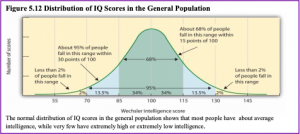
One end of the distribution of intelligence scores is defined by people with very low IQ. Intellectual disability (or intellectual developmental disorder) is assessed based on cognitive capacity (IQ) and adaptive functioning. The severity of the disability is based on adaptive functioning, or how well the person handles everyday life tasks. About 1% of the United States population, most of them males, fulfill the criteria for the intellectual developmental disorder, but some children who are given this diagnosis lose the classification as they get older and better learn to function in society. A particular vulnerability of people with low IQ is that they may be taken advantage of by others, and this is an important aspect of the definition of intellectual developmental disorder (Greenspan, Loughlin, & Black, 2001).
One cause of the intellectual developmental disorder is Down syndrome, a chromosomal disorder caused by the presence of all or part of an extra 21st chromosome. The incidence of Down syndrome is estimated at approximately 1 per 700 births, and the prevalence increases as the mother’s age increases (CDC, 2014). People with Down syndrome typically exhibit a distinctive pattern of physical features, including a flat nose, upwardly slanted eyes, a protruding tongue, and a short neck (see Figure 5.14).
Fortunately, societal attitudes toward individuals with intellectual disabilities have changed over the past decades. Laws such as the Americans with Disabilities Act (ADA) have made it illegal to discriminate on the basis of mental and physical disability, and there has been a trend to bring people with intellectual disabilities out of institutions and into our workplaces and schools.
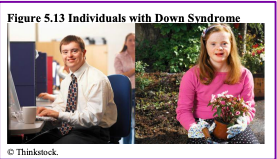
Giftedness refers to children who have an IQ of 130 or higher (Lally & Valentine-French, 2015). Having extremely high IQ is clearly less of a problem than having extremely low IQ, but there may also be challenges to being particularly smart. It is often assumed that schoolchildren who are labeled as “gifted” may have adjustment problems that make it more difficult for them to create social relationships. To study gifted children, Lewis Terman and his colleagues (Terman & Oden, 1959) selected about 1,500 high school students who scored in the top 1% on the Stanford-Binet and similar IQ tests (i.e., who had IQs of about 135 or higher), and tracked them for more than seven decades (the children became known as the “termites” and are still being studied today). This study found that these students were not unhealthy or poorly adjusted, but rather were above average in physical health and were taller and heavier than individuals in the general population. The students also had above-average social relationships and were less likely to divorce than the average person (Seagoe, 1975).
Terman’s study also found that many of these students went on to achieve high levels of education and entered prestigious professions, including medicine, law, and science. Of the sample, 7% earned doctoral degrees, 4% earned medical degrees, and 6% earned law degrees.

These numbers are all considerably higher than what would have been expected from a more general population. Another study of young adolescents who had even higher IQs found that these students ended up attending graduate school at a rate more than 50 times higher than that in the general population (Lubinski & Benbow, 2006).
As you might expect based on our discussion of intelligence, kids who are gifted have higher scores on general intelligence “g”, but there are also different types of giftedness. Some children are particularly good at math or science, some at automobile repair or carpentry, some at music or art, some at sports or leadership, and so on. There is a lively debate among scholars about whether it is appropriate or beneficial to label some children as “gifted and talented” in school and to provide them with accelerated special classes and other programs that are not available to everyone. Although doing so may help the gifted kids (Colangelo & Assouline, 2009), it also may isolate them from their peers and make such provisions unavailable to those who are not classified as “gifted.”
Education
Remember the ecological systems model (Bronfenbrenner, 1979) that we explored in chapter one? This model helps us understand an individual by examining the contexts in which the person lives and the direct and indirect influences on that person’s life. School becomes a very important component of children’s lives during middle and late childhood, and parents and the culture contribute to children’s experiences in school as indicated by the ecological systems model through their interaction with the school.
Gender: The stereotypes held by parents and teachers can influence children’s self-efficacy in various domains. For example, teachers who hold the view that girls are better at reading (Retelsdorf, Schwartz, & Asbrock, 2015) or boys are better at math (Plante, de la Sablonnière, Aronson, & Théorêt, 2013) often find that their students’ performance in these areas mirror these stereotypes, despite the children’s actual ability, or the ability of children in the classrooms of teachers who do not hold such stereotypes. While not all children will internalize the views of others, those who do are more likely to show declines in their performance consistent with the stereotypes (Plante, et al., 2013; Retelsdorf et al., 2015).
Parental Involvement in School: Parents vary in their level of involvement with their children’s schools. Teachers often complain that they have difficulty getting parents to participate in their child’s education and devise a variety of techniques to keep parents in touch with daily and overall progress. For example, parents may be required to sign a behavior chart each evening to be returned to school or may be given information about the school’s events through websites and newsletters. There are other factors that need to be considered when looking at parental involvement. To explore these, first ask yourself if all parents who enter the school with concerns about their child be received in the same way?
Horvat (2004) found that teachers seek a particular type of involvement from particular types of parents. While teachers thought they were open and neutral in their responses to parental involvement, in reality teachers were most receptive to support, praise and agreement coming from parents who were most similar in race and social class with the teachers. Parents who criticized the school or its policies were less likely to be given voice. Parents who have higher levels of income, occupational status, and other qualities favored in society have family capital. This is a form of power that can be used to improve a child’s education. Parents who do not have these qualities may find it more difficult to be effectively involved. The authors suggest that teachers closely examine their biases against parents. Schools may also need to examine their ability to dialogue with parents about school policies in more open ways. Any efforts to improve effective parental involvement should address these concerns.
Cultural Differences in the Classroom
Bilingualism: In 2013, approximately 20% of school aged children and adolescents spoke a language other than English in the home (Camarota & Zeigler, 2014). The majority of bilingual students speak Spanish, but the rest represent more than three hundred different language groups from around the world. In larger communities throughout the United States, it is therefore common for a single classroom to contain students from several language backgrounds at once. In classrooms, as in other social settings, bilingualism exists in different forms and degrees. At one extreme are students who speak both English and another language fluently; at the other extreme are those who speak only limited versions of both languages. In between are students who speak their home (or heritage) language much better than English, as well as others who have partially lost their heritage language in the process of learning English (Tse, 2001). Commonly, a student may speak a language satisfactorily, but be challenged by reading or writing it. Whatever the case, each bilingual student poses unique challenges to teachers.

The student who speaks both languages fluently has a definite cognitive advantage. As you might suspect, and research confirms, a fully fluent bilingual student is in a better position to express concepts or ideas in more than one way, and to be aware of doing so (Jimenez, Garcia, & Pearson, 1995; Francis, 2006). Unfortunately, the bilingualism of many students is unbalanced in the sense that they are either still learning English, or else they have lost some earlier ability to use their original, heritage language. Losing one’s original language is a concern as research finds that language loss limits students’ ability to learn English as well or as quickly as they could do. Having a large vocabulary in a first language has been shown to save time in learning vocabulary in a second language (Hansen, Umeda & McKinney, 2002). Preserving the first language is important if a student has impaired skill in all languages and therefore needs intervention or help from a speech-language specialist. Research has found, in such cases, that the specialist can be more effective if the specialist speaks and uses the first language as well as English (Kohnert, Yim, Nett, Kan, & Duran, 2005).
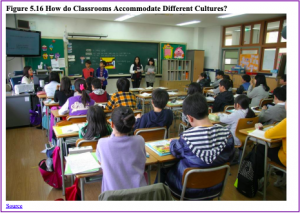
Cultures and ethnic groups differ not only in languages, but also in how languages are used. Since some of the patterns differ from those typical of modern classrooms, they can create misunderstandings between teachers and students (Cazden, 2001; Rogers, et al., 2005). Consider these examples:
- In some cultures, it is considered polite or even intelligent not to speak unless you have something truly important to say. Chitchat, or talk that simply affirms a personal tie between people, is considered immature or intrusive (Minami, 2002). In a classroom, this habit can make it easier for a child to learn not to interrupt others, but it can also make the child seem unfriendly.
- Eye contact varies by culture. In many African American and Latin American communities, it is considered appropriate and respectful for a child not to look directly at an adult who is speaking to them (Torres-Guzman, 1998). In classrooms, however, teachers often expect a lot of eye contact (as in “I want all eyes on me!”) and may be tempted to construe lack of eye contact as a sign of indifference or disrespect.
- Social distance varies by culture. In some cultures, it is common to stand relatively close when having a conversation; in others, it is more customary to stand relatively far apart (Beaulieu, 2004). Problems may happen when a teacher and a student prefer different social distances. A student who expects a closer distance than does the teacher may seem overly familiar or intrusive, whereas one who expects a longer distance may seem overly formal or hesitant.
- Wait time varies by culture. Wait time is the gap between the end of one person’s comment or question and the next person’s reply or answer. In some cultures wait time is relatively long, as long as three or four seconds (Tharp & Gallimore, 1989). In others it is a negative gap, meaning that it is acceptable, even expected, for a person to interrupt before the end of the previous comment. In classrooms the wait time is customarily about one second; after that, the teacher is likely to move on to another question or to another student. A student who habitually expects a wait time longer than one second may seem hesitant, and not be given many chances to speak. A student who expects a negative wait time, on the other hand, may seem overeager or even rude.
- In most non-Anglo cultures, questions are intended to gain information, and it is assumed that a person asking the question truly does not have the information requested (Rogoff, 2003). In most classrooms, however, teachers regularly ask test questions, which are questions to which the teacher already knows the answer and that simply assess whether a student knows the answer as well (Macbeth, 2003). The question: “How much is 2 + 2?” for example, is a test question. If the student is not aware of this purpose, he or she may become confused, or think that the teacher is surprisingly ignorant. Worse yet, the student may feel that the teacher is trying deliberately to shame the student by revealing the student’s ignorance or incompetence to others.
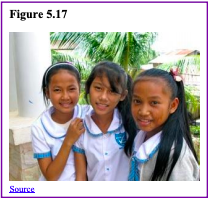
- Preference for activities that are cooperative rather than competitive. Many activities in school are competitive, even when teachers try to de-emphasize the competition. Once past the first year or second year of school, students often become attentive to who receives the highest marks on an assignment, for example, or who is the best athlete at various sports or whose contributions to class discussions gets the most verbal recognition from the teacher (Johnson & Johnson, 1998). A teacher deliberately organizes important activities or assignments competitively, as in “Let’s see who finishes the math sheet first”. Classroom life can then become explicitly competitive, and the competitive atmosphere can interfere with cultivating supportive relationships among students or between students and the teacher (Cohen, 2004). For students who give priority to these relationships, competition can seem confusing at best and threatening at worst. A student may wonder, “What sort of sharing or helping with answers is allowed?” The answer to this question may be different depending on the cultural background of the student and teacher. What the student views as cooperative sharing may be seen by the teacher as laziness, freeloading, or even cheating.
Figure 5.1
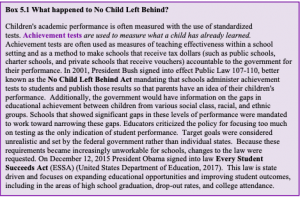
Children with Disabilities
A Learning Disability (or LD) is a specific impairment of academic learning that interferes with a specific aspect of schoolwork and that reduces a student’s academic performance significantly. A LD shows itself as a major discrepancy between a student’s ability and some feature of achievement: The student may be delayed in reading, writing, listening, speaking, or doing mathematics, but not in all of these at once. A learning problem is not considered a learning disability if it stems from physical, sensory, or motor handicaps, or from generalized intellectual impairment. It is also not an LD if the learning problem really reflects the challenges of learning English as a second language. Genuine LDs are the learning problems left over after these other possibilities are accounted for or excluded. Typically, a student with an LD has not been helped by teachers’ ordinary efforts to assist the student when he or she falls behind academically, though what counts as an “ordinary effort”, of course, differs among teachers, schools, and students. Most importantly, though, an LD relates to a fairly specific area of academic learning. A student may be able to read and compute well enough, for example, but not be able to write. LDs are by far the most common form of special educational need, accounting for half of all students with special needs in the United States and approximately 20% of all students, depending on how the numbers are estimated (National Center for Learning Disabilities, 2017). Students with LDs are so common, in fact, that most teachers regularly encounter at least one per class in any given school year, regardless of the grade level they teach.
These difficulties are identified in school because this is when children’s academic abilities are being tested, compared, and measured. Consequently, once academic testing is no longer essential in that person’s life (as when they are working rather than going to school) these disabilities may no longer be noticed or relevant, depending on the person’s job and the extent of the disability.
Dyslexia is one of the most commonly diagnosed disabilities and involves having difficulty in the area of reading. This diagnosis is used for a number of reading difficulties. Common characteristics are difficulty with phonological processing, which includes the manipulation of sounds, spelling, and rapid visual/verbal processing. Additionally, the child may reverse letters, have difficulty reading from left to right, or may have problems associating letters with sounds. It appears to be rooted in neurological problems involving the parts of the brain active in recognizing letters, verbally responding, or being able to manipulate sounds. Recent studies have identified a number of genes that are linked to developing dyslexia (National Institute of Neurological Disorders and Stroke, 2016). Treatment typically involves altering teaching methods to accommodate the person’s particular problematic area.
Dysgraphia refers to a writing disability that is often associated with dyslexia (Carlson, 2013). There are different types of dysgraphia, including phonological dysgraphia when the person cannot sound out words and write them phonetically. Orthographic dysgraphia is demonstrated by those individuals who can spell regularly spelled words, but not irregularly spelled ones. Some individuals with dysgraphia experience difficulties in motor control and experience trouble forming letters when using a pen or pencil.

Dyscalculia refers to problems in math. Cowan and Powell (2014) identified several terms used when describing difficulties in mathematics including dyscalculia, mathematical learning disability, and mathematics disorder. All three terms refer to students with average intelligence who exhibit poor academic performance in mathematics. When evaluating a group of third graders, Cowan and Powell (2014) found that children with dyscalculia demonstrated problems with working memory, reasoning, processing speed and oral language, all of which are referred to as domain-general factors. Additionally, problems with multi-digit skills, including number system knowledge, were also exhibited.
A child with attention-deficit/hyperactivity disorder (ADHD) shows a constant pattern of inattention and/or hyperactive and impulsive behavior that interferes with normal functioning (American Psychological Association (APA), 2013). Some of the signs of inattention include great difficulty with, and avoidance of, tasks that require sustained attention (such as conversations or reading), failure to follow instructions (often resulting in failure to complete schoolwork and other duties), disorganization (difficulty keeping things in order, poor time management, sloppy and messy work), lack of attention to detail, becoming easily distracted, and forgetfulness. Hyperactivity is characterized by excessive movement and includes fidgeting or squirming, leaving one’s seat in situations when remaining seated is expected, having trouble sitting still (e.g., in a restaurant), running about and climbing on things, blurting out responses before another person’s question or statement has been completed, difficulty waiting for one’s turn for something, and interrupting and intruding on others. Frequently, the hyperactive child comes across as noisy and boisterous. The child’s behavior is hasty, impulsive, and seems to occur without much forethought; these characteristics may explain why adolescents and young adults diagnosed with ADHD receive more traffic tickets and have more automobile accidents than do others their age (Thompson, Molina, Pelham, & Gnagy, 2007).
ADHD occurs in about 5% of children (APA, 2013). On average, boys are 3 times more likely to have ADHD than are girls; however, such findings might reflect the greater propensity of boys to engage in aggressive and antisocial behavior and thus incur a greater likelihood of being referred to psychological clinics (Barkley, 2006). Children with ADHD face severe academic and social challenges. Compared to their non-ADHD counterparts, children with ADHD have lower grades and standardized test scores and higher rates of expulsion, grade retention, and dropping out. They also are less well-liked and more often rejected by their peers (Hoza et al., 2005).

ADHD can persist into adolescence and adulthood (Barkley, Fischer, Smallish, & Fletcher, 2002). A recent study found that 29.3% of adults who had been diagnosed with ADHD decades earlier still showed symptoms (Barbaresi et al., 2013). Somewhat troubling, this study also reported that nearly 81% of those whose ADHD persisted into adulthood had experienced at least one other comorbid disorder, compared to 47% of those whose ADHD did not persist. Additional concerns when an adult has ADHD include Worse educational attainment, lower socioeconomic status, less likely to be employed, more likely to be divorced, and more likely to have non-alcohol-related substance abuse problems (Klein et al., 2012).
Etiology of ADHD: Family and twin studies indicate that genetics play a significant role in the development of ADHD. Burt (2009), in a review of 26 studies, reported that the median rate of concordance for identical twins was .66, whereas the median concordance rate for fraternal twins was .20. The specific genes involved in ADHD are thought to include at least two that are important in the regulation of the neurotransmitter dopamine (Gizer, Ficks, & Waldman, 2009), suggesting that dopamine may be important in ADHD. Indeed, medications used in the treatment of ADHD, such as methylphenidate (Ritalin) and amphetamine with dextroamphetamine (Adderall), have stimulant qualities and elevate dopamine activity. People with ADHD show less dopamine activity in key regions of the brain, especially those associated with motivation and reward (Volkow et al., 2009), which provides support to the theory that dopamine deficits may be a vital factor in the development this disorder (Swanson et al., 2007).
Brain imaging studies have shown that children with ADHD exhibit abnormalities in their frontal lobes, an area in which dopamine is in abundance. Compared to children without ADHD, those with ADHD appear to have smaller frontal lobe volumes, and they show less frontal lobe activation when performing mental tasks (Banaschewski et al., 2017). Recall that one of the functions of the frontal lobes is to inhibit our behavior. Thus, abnormalities in this region may go a long way toward explaining the hyperactive, uncontrolled behavior of ADHD.
Many parents attribute their child’s hyperactivity to sugar. A statistical review of 16 studies, however, concluded that sugar consumption has no effect at all on the behavioral and cognitive performance of children (Wolraich, Wilson, & White, 1995). Additionally, although food additives have been shown to increase hyperactivity in non-ADHD children, the effect is rather small (McCann et al., 2007). Numerous studies, however, have shown a significant relationship between exposure to nicotine in cigarette smoke during the prenatal period and ADHD (Linnet et al., 2003; Sourander et al., 2019). Maternal smoking during pregnancy is also associated with the development of more severe symptoms of the disorder (Thakuretal., 2013). Additionally, low birth weight and prematurity have been correlated with ADHD (Banaschewski et al., 2017).
Treatment for ADHD: Recommended treatment for ADHD includes behavioral interventions, cognitive behavioral therapy, parent and teacher education, recreational programs, and lifestyle changes, such as getting more sleep (Clay, 2013). For some children, medication is prescribed. Parents are often concerned that stimulant medication may result in their child acquiring a substance use disorder. However, research using longitudinal studies has demonstrated that children diagnosed with ADHD who received pharmacological treatment had a lower risk for substance abuse problems than those children who did not receive medication (Wilens, Fararone, Biederman, & Gunawardene, 2003). The risk of substance abuse problems appears to be even greater for those with ADHD who are un-medicated and also exhibit antisocial tendencies (Marshal & Molina, 2006).
Is the prevalence rate of ADHD increasing? Many people believe that the rates of ADHD have increased in recent years, and there is evidence to support this contention. In a recent study, investigators found that the parent-reported prevalence of ADHD among children (4–17 years old) in the United States increased by 22% during a 4-year period, from 7.8% in 2003 to 9.5% in 2007 (CDC, 2010). ADHD may be over-diagnosed by doctors who are too quick to medicate children as behavior treatment. There is also greater awareness of ADHD now than in the past. Nearly everyone has heard of ADHD, and most parents and teachers are aware of its key symptoms. Thus, parents may be quick to take their children to a doctor if they believe their child possesses these symptoms, or teachers may be more likely now than in the past to notice the symptoms and refer the child for evaluation. Further, the use of computers, video games, iPhones, and other electronic devices has become pervasive among children in the early 21st century, and these devices could potentially shorten children’s attention spans.
Thus, what might seem like inattention to some parents and teachers could simply reflect exposure to too much technology.
Children with Disabilities: Legislation
Since the 1970s political and social attitudes have moved increasingly toward including people with disabilities into a wide variety of “regular” activities. In the United States, the shift is illustrated clearly in the Federal legislation that was enacted during this time. Three major laws were passed that guaranteed the rights of persons with disabilities, and of children and students with disabilities in particular. The third law has had the biggest impact on education.
Rehabilitation Act of 1973, Section 504: This law, the first of its kind, required that individuals with disabilities be accommodated in any program or activity that receives Federal funding (PL 93-112, 1973). Although this law was not intended specifically for education, in practice it has protected students’ rights in some extra-curricular activities (for older students) and in some child care or after-school care programs (for younger students). If those programs receive Federal funding of any kind, the programs are not allowed to exclude children or youths with disabilities, and they have to find reasonable ways to accommodate the individuals’ disabilities.
Americans with Disabilities Act of 1990 (or ADA): This legislation also prohibited discrimination on the basis of disability, just as Section 504 of the Rehabilitation Act had done (PL 101-336, 1990). Although the ADA also applies to all people (not just to students), its provisions are more specific and “stronger” than those of Section 504. In particular, ADA extends to all employment and jobs, not just those receiving Federal funding. It also specifically requires accommodations to be made in public facilities such as with buses, restrooms, and telephones. ADA legislation is therefore responsible for some of the “minor” renovations in schools that you may have noticed in recent years, like wheelchair-accessible doors, ramps, and restrooms, and public telephones with volume controls.
Individuals with Disabilities Education Act (or IDEA): As its name implied, this legislation was more focused on education than either Section 504 or ADA. It was first passed in 1975, reauthorized in 2004 (PL 108-446, 2004), and most recently amended in 2015 through Public Law 114-95, as the Every Student Succeeds Act (United States Department of Education, 2017). In its current form, the law guarantees the following rights related to education for anyone with a disability from birth to age 21. The first two influence schooling in general, but the last three affect the work of classroom teachers rather directly:
- Free, appropriate education: An individual or an individual’s family should not have to pay for education simply because the individual has a disability, and the educational program should be truly educational; i.e., not merely care-taking or babysitting the person.
- Due process: In case of disagreements between an individual with a disability and the schools or other professionals, there must be procedures for resolving the disagreements that are fair and accessible to all parties, including the person himself or herself or the person’s representative.
- A fair evaluation of performance in spite of disability: Tests or other evaluations should not assume test-taking skills that a person with a disability cannot reasonably be expected to have, such as holding a pencil, hearing or seeing questions, working quickly, or understanding and speaking orally. Evaluation procedures should be modified to allow for these differences. This provision of the law applies both to evaluations made by teachers and to school-wide or “high-stakes” testing programs.
- Education in the “least restrictive environment”: Education for someone with a disability should provide as many educational opportunities and options for the person as possible, both in the short term and in the long term. In practice, this requirement has meant including students in regular classrooms and school activities as much as possible, though often not totally.
- An individualized educational program (IEP): Given that every disability is unique, instructional planning for a person with a disability should be unique or individualized as well. In practice this provision has led to classroom teachers planning individualized programs jointly with other professionals (like reading specialists, psychologists, or medical personnel) as part of a team.
Evaluation and diagnosis can be the first step in helping provide children with disabilities the type of instruction and resources that will benefit them educationally, but diagnosis and labeling also have social implications. It is important to consider that children can be misdiagnosed and that once a child has received a diagnostic label, the child, teachers, and family members may tend to interpret actions of the child through that label. The label can also influence the child’s self-concept. Consider, for example, a child who is misdiagnosed as learning disabled. That child may expect to have difficulties in school, lack confidence, and because of these expectations experience trouble. This self-fulfilling prophecy or tendency to act in such a way as to make what you predict will happen, will come true.
This calls our attention to the power that labels can have whether or not they are accurately applied. It is also important to consider that children’s difficulties can change over time; a child who has problems in school, may improve later or may live under circumstances as an adult where the problem (such as a delay in math skills or reading skills) is no longer relevant. That person, however, will still have a label as learning disabled. It should be recognized that the distinction between abnormal and normal behavior is not always clear; some abnormal behavior in children is fairly common.
References
Aiken, L. R. (1994). Psychological testing and assessment (8th ed.). Needham Heights, MA: Allyn and Bacon.
Alloway, T. P. (2009). Working memory, but not IQ, predicts subsequent learning in children with learning difficulties. European Journal of Psychological Assessment, 25, 92-98.
Alloway, T. P., Bibile, V., & Lau, G. (2013). Computerized working memory training: Can lead to gains in cognitive skills in students? Computers in Human Behavior, 29, 632-638.
American Civil Liberties Union (2016). Overview of lesbian and gay parenting, adoption and foster care. Retrieved from https://www.aclu.org/fact-sheet/overview-lesbian-and-gay-parenting-adoption-and-foster-care?redirect=overviewlesbian-and-gay-parenting-adoption-and-foster-care
American Psychiatric Association. (2013). Diagnostic and statistical manual of mental disorders (5th ed.). Washington, DC: American Psychiatric Association.
American Speech-Language and Hearing Association. (2016). Voice disorders. Retrieved from http://www.asha.org/PracticePortal/Clinical-Topics/Voice-Disorders/ Arditti, J. A. (1999). Rethinking relationships between divorced mothers and their children: Capitalizing on family strengths. Family Relations, 48, 109-119.
Anderson, J. (2018). The impact of family structure on the health of children: Effects of divorce. The Linacre Quarterly 81(4), 378–387.
Arkowicz, H., & Lilienfeld. (2013). Is divorce bad for children? Scientific American Mind, 24(1), 68-69. Figure 5.27 206
Asher, S. R., & Hymel, S. (1981). Children’s social competence in peer relations: Sociometric and behavioral assessment. In J. K. Wine & M. D. Smye (Eds.), Social competence (pp. 125-157). New York: Guilford Press.
Banaschewski, T., Becker, K., Döpfner, M., Holtmann, M., Rösler, M., & Romanos, M. (2017). Attention-deficit/hyperactivity disorder. A current overview. Deutsches Ärzteblatt International, 114, 149-159.
Bandura, A. (1977). Self-efficacy: Toward a unifying theory of behavioral change. Psychological Review, 84, 191-215.
Bandura, A. (1986). Social foundations of thought and action: A social cognitive theory. Englewood Cliffs, NJ: Prentice Hall.
Bandura, A. (1997). Self-efficacy: The exercise of control. New York: Freeman.
Barnett, N. P., Smoll, F. L., & Smith, R. E. (1992). Effects of enhancing coach-athlete relationships on youth sport attrition. The Sport Psychologist, 6, 111-127.
Barbaresi, W. J., Colligan, R. C., Weaver, A. L., Voigt, R. G., Killian, J. M., & Katusic, S. K. (2013). Mortality, ADHD, and psychosocial adversity in adults with childhood ADHD: A prospective study. Pediatrics, 131, 637–644.
Barkley, R. A. (2006). Attention-deficit hyperactivity disorder: A handbook for diagnosis and treatment. New York, NY: Guilford Press.
Barkley, R. A., Fischer, M., Smallish, L., & Fletcher, K. (2002). The persistence of attention-deficit/hyperactivity disorder into young adulthood as a function of reporting source and definition of disorder. Journal of Abnormal Psychology, 111, 279–289.
Beaulieu, C. (2004). Intercultural study of personal space: A case study. Journal of Applied Social Psychology, 34(4), 794-805.
Berk, L. (2007). Development through the life span (4th ed.). Boston: Allyn and Bacon. Berger, K. S. (2014). The developing person: Through the life span. NY: Worth Publishers.
Bigelow, B. J. (1977). Children’s friendship expectations: A cognitive developmental study. Child Development, 48, 246–253.
Bigelow, B. J., & La Gaipa, J. J. (1975). Children’s written descriptions of friendship: A multidimensional analysis. Developmental Psychology, 11(6), 857-858.
Binet, A., Simon, T., & Town, C. H. (1915). A method of measuring the development of the intelligence of young children (3rd ed.) Chicago, IL: Chicago Medical Book.
Bink, M. L., & Marsh, R. L. (2000). Cognitive regularities in creative activity. Review of General Psychology, 4(1), 59–78.
Bjorklund, D. F. (2005). Children’s thinking: Developmental function and individual differences (4th ed.). Belmont, CA: Wadsworth.
Black, J. A., Park, M., Gregson, J. (2015). Child obesity cut-offs as derived from parental perceptions: Cross-sectional questionnaire. British Journal of General Practice, 65, e234-e239.
Boulton, M. J. (1999). Concurrent and longitudinal relations between children’s playground behavior and social preference, victimization, and bullying. Child Development, 70, 944-954.
Brody, N. (2003). Construct validation of the Sternberg Triarchic Abilities Test: Comment and reanalysis. Intelligence, 31(4), 319–329.
Bronfenbrenner, U. (1979). The ecology of human development: Experiments by nature and design. Cambridge, MA: Harvard Univeristy Press.
Brown, S. L. (2000). Union transitions among cohabitors: The significance of relationship assessments and expectations. Journal of Marriage and the Family, 62, 833-846. 207
Bruning, R. H., Schraw, G. J., Norby, M. M., & Ronning, R. R. (2004). Cognitive psychology and instruction. Upper Saddle River, NJ: Pearson.
Burt, S. A. (2009). Rethinking environmental contributions to child and adolescent psychopathology: A meta-analysis of shared environmental influences. Psychological Bulletin, 135, 608–637.
Carlson, N. (2013). Physiology of behavior. Upper Saddle River, NJ: Pearson Education.
Carlson, S. M., & Zelazo, P. D., & Faja, S. (2013). Executive function. In P. D. Zelazo (Ed.), The Oxford handbook of developmental psychology, Vol. 1: Body and mind (pp. 706-743). New York: Oxford University Press
Camarota, S. A., & Zeigler, K. (2015). One in five U. S. residents speaks foreign language at home. Retrieved from https://cis.org/sites/default/files/camarota-language-15.pdf
Cazden, C. (2001). Classroom discourse, (2nd ed.). Portsmouth, NH: Heineman Publishers.
Centers for Disease Control and Prevention. (2000). 2000 CDC growth charts for the United States: Methods and development. Retrieved from http://www.cdc.gov/nchs/data/series/sr_11/sr11_246.pdf
Centers for Disease Control and Prevention. (2010, November 12). Increasing prevalence of parent reported attentiondeficit/hyperactivity disorder among children, United States, 2003–2007. Morbidity and Mortality Weekly Report, 59(44), 1439–1443.
Centers for Disease Control and Prevention. (2014). Birth defects. Retrieved from https://www.cdc.gov/ncbddd/birthdefects/downsyndrome/data.html
Chao, R. (2001). Extending research on the consequences of parenting styles for Chinese Americans and European Americans. Child Development, 72, 1832-1843.
Cillesen, A. H., & Mayeaux, L. (2004). From censure to reinforcement: Developmental changes in the association between aggression and social status. Child Development, 75, 147-163.
Clark, M. L., & Bittle, M. L. (1992). Friendship expectations and the evaluation of present friendships in middle childhood and early adolescence. Child Study Journal, 22, 115–135.
Clay, R. A. (2013). Psychologists are using research-backed behavioral interventions that effectively treat children with ADHD. Monitor on Psychology, 44(2), 45-47.
Cohen, E. (2004). Teaching cooperative learning: The challenge for teacher education. Albany, NY: State University of New York Press.
Colangelo, N., & Assouline, S. (2009). Acceleration: Meeting the academic and social needs of students. In T. Balchin, B. Hymer, & D. J. Matthews (Eds.), The Routledge international companion to gifted education (pp. 194–202). New York, NY: Routledge.
Cowan, R., & Powell, D. (2014). The contributions of domain-general and numerical factors to third-grade arithmetic skills and mathematical learning disability. Journal of Educational Psychology, 106, 214-229.
Crain, W. (2005). Theories of development (5th ed.). Upper Saddle River, NJ: Pearson.
Davidson, T. L. (2014). Do impaired memory and body weight regulation originate in childhood with diet-induced hippocampal dysfunction? The American Journal of Clinical Nutrition, 99(5), 971-972.
Davidson, T. L., Hargrave, S. L., Swithers, S. E., Sample, C. H., Fu, X., Kinzig, K. P., & Zheng, W. (2013). Inter-relationships among diet, obesity, and hippocampal-dependent cognitive function. Neuroscience, 253, 110-122.
de Ribaupierre, A. (2002). Working memory and attentional processes across the lifespan. In P. Graf & N. Ohta (Eds.), Lifespan of development of human memory (pp. 59-80). Cambridge, MA: The MIT Press. 208
Discover Esports. (2017). What are esports? Retrieved from https://discoveresports.com/what-are-esports/
Doolen, J., Alpert, P. T. and Miller, S. K. (2009), Parental disconnect between perceived and actual weight status of children: A metasynthesis of the current research. Journal of the American Academy of Nurse Practitioners, 21, 160–166. doi:10.1111/j.1745-7599.2008.00382.x
Drexler, P. (2005). Raising boys without men. Emmaus, PA: Rodale.
Dutton, E., van der Linden, D., Lynn, R. (2016). The negative Flynn effect: A systematic literature review. Intelligence, 59, 163- 169. Ennis, R. H. (1987). A taxonomy of critical thinking dispositions and abilities. In J. Baron & R. Sternberg (Eds.), Teaching thinking skills: Theory and practice (pp. 9-26). New York: Freeman.
Ericsson, K. (1998). The scientific study of expert levels of performance: General implications for optimal learning and creativity. High Ability Studies, 9(1), 75–100.
Erikson, E. (1982). The life cycle completed. NY: Norton & Company.
Flynn, J. R. (1999). Searching for justice: The discovery of IQ gains over time. American Psychologist, 54(1), 5–20.
Francis, N. (2006). The development of secondary discourse ability and metalinguistic awareness in second language learners. International Journal of Applied Linguistics, 16, 37-47.
Fraser-Thomas, J. L., Côté, J., & Deakin, J. (2005). Youth sport programs: An avenue to foster positive youth development. Physical Education & Sport Pedagogy, 10, 19-40.
Furnham, A., & Bachtiar, V. (2008). Personality and intelligence as predictors of creativity. Personality and Individual Differences, 45(7), 613–617.
Furstenberg, F. F., & Cherlin, A. J. (1991). Divided families: What happens to children when parents part. Cambridge, MA: Harvard University Press.
Gardner, H. (1983). Frames of mind: The theory of multiple intelligences. New York: Basic Books.
Gardner, H. (1999). Intelligence reframed: Multiple intelligences for the 21st century. New York, NY: Basic Books.
Gilligan, C. (1982). In a different voice: Psychological theory and women’s development. Cambridge, MA: Harvard University Press.
Gizer, I. R., Ficks, C., & Waldman, I. D. (2009). Candidate gene studies of ADHD: A meta-analytic review. Human Genetics, 126, 51–90.
Gottfredson, L. S. (1997). Mainstream science on intelligence: An editorial with 52 signatories, history and bibliography. Intelligence, 24(1), 13–23.
Gottfredson, L. S. (2003). Dissecting practical intelligence theory: Its claims and evidence. Intelligence, 31(4), 343–397.
Greenspan, S., Loughlin, G., & Black, R. S. (2001). Credulity and gullibility in people with developmental disorders: A framework for future research. In L. M. Glidden (Ed.), Internationalreview ofresearch in mental retardation (Vol. 24, pp. 101–135). San Diego, CA: Academic Press.
Guttmann, J. (1993). Divorce in psychosocial perspective: Theory and research. Hillsdale, NJ: L. Erlbaum Associates.
Haidt, J. (2001). The emotional dog and its rational tail: A social intuitionist approach to moral judgment. Psychological Review, 108(4), 814–834.
Hales, C.M., Carroll, M.D., Fryar, C.D., & Ogden, C.L. (2017). Prevalence of obesity among adults and youth: United States, 2015–2016. NCHS data brief, no 288. Hyattsville, MD: National Center for Health Statistics. 209
Halpern, D. F. (1992). Sex differences in cognitive abilities (2nd ed.). Hillsdale, NJ: Lawrence Erlbaum Associates.
Hansen, L., Umeda, Y., & McKinney, M. (2002). Savings in the relearning of second language vocabulary: The effects of time and proficiency. Language Learning, 52, 653-663.
Hartup, W. W. (1983). Adolescents and their friends. New Directions for Child and Adolescent Development, 60, 3-22.
Hennessey, B. A., & Amabile, T. M. (2010). Creativity. Annual Review of Psychology, 61, 569–598.
Hetherington, E. M., & Kelly, J. (2002). For better or for worse: Divorce reconsidered. New York: W.W. Norton.
Horvat, E. M. (2004). Moments of social inclusion and exclusion: Race, class, and cultural capital in family-school relationships. In A. Lareau (Author) & J. H. Ballantine & J. Z. Spade (Eds.), Schools and society: A sociological approach to education (2nd ed., pp. 276-286). Belmont, CA: Wadsworth.
Hoza, B., Mrug, S., Gerdes, A. C., Hinshaw, S. P., Bukowski, W. M., Gold, J. A., . . . Arnold, L. E. (2005). What aspects of peer relationships are impaired in children with ADHD? Journal of Consulting and Clinical Psychology, 73, 411–423.
Inhelder, B., & Piaget, J. (1958). The growth of logical thinking from childhood to adolescence. New York: Basic Books.
Jaffee, S., & Hyde, J. S. (2000). Gender differences in moral orientation: A meta-analysis. Psychological Bulletin, 126(5), 703– 726.
Jimenez, R., Garcia, G., & Pearson. D. (1995). Three children, two languages, and strategic reading: Case studies in bilingual/monolingual reading. American Educational Research Journal, 32 (1), 67-97. Johnson, D., & Johnson, R. (1998). Learning together and alone: Cooperative, competitive, and individualistic learning, (5th ed.). Boston: Allyn & Bacon.
Johnson, M. (2005). Developmental neuroscience, psychophysiology, and genetics. In M. Bornstein & M. Lamb (Eds.), Developmental science: An advanced textbook (5th ed., pp. 187-222).
Hillsdale, NJ: Erlbaum. Johnson, W., Carothers, A., & Deary, I. J. (2009). A role for the X chromosome in sex differences in variability in general intelligence? Perspectives on Psychological Science, 4(6), 598–611.
Kail, R. V., McBride-Chang, C., Ferrer, E., Cho, J.R., & Shu, H. (2013). Cultural differences in the development of processing speed. Developmental Science, 16, 476-483.
Katz, D. L. (2015). Oblivobesity: Looking over the overweight that parents keep overlooking. Childhood Obesity, 11(3), 225- 226.
Klein, R. G., Mannuzza, S., Olazagasti, M. A. R., Roizen, E., Hutchison, J. A., Lashua, E. C., & Castellanos, F. X. (2012). Clinical and functional outcome of childhood attention-deficit/hyperactivity disorder 33 years later. Archives of General Psychiatry, 69, 1295–1303.
Klima, T., & Repetti, R. L. (2008). Children’s peer relations and their psychological adjustment: Differences between close friends and the larger peer group. Merrill-Palmer Quarterly, 54, 151-178.
Kohlberg, L. (1963). The development of children’s orientations toward a moral order: Sequence in the development of moral thought. Vita Humana, 16, 11-36.
Kohlberg, L. (1984). The psychology of moral development: Essays on moral development (Vol. 2, p. 200). San Francisco, CA: Harper & Row.
Kohnert, K., Yim, D., Nett, K., Kan, P., & Duran, L. (2005). Intervention with linguistically diverse preschool children. Language, Speech, and Hearing Services in Schools, 36, 251-263.
Lally, M. J., & Valentine-French, S. J. (2018). Introduction to Psychology [Adapted from Charles Stangor, Introduction to Psychology] Grayslake, IL: College of Lake County. 210
Liang, J., Matheson, B., Kaye, W., & Boutelle, K. (2014). Neurocognitive correlates of obesity and obesity-related behaviors in children and adolescents. International Journal of Obesity, 38(4), 494-506
Linnet, K. M., Dalsgaard, S., Obel, C., Wisborg, K., Henriksen, T. B., Rodriquez, A., . . . Jarvelin, M. R.(2003). Maternal lifestyle factors in pregnancy risk of attention deficit hyperactivity disorder and associated behaviors: A review of current evidence. The American Journal of Psychiatry, 160, 1028–1040.
Livingston, G. (2018). About one-third of U.S. children are living with an unmarried parent. Retrieved from https://www.pewresearch.org/fact-tank/2018/04/27/about-one-third-of-u-s-children-are-living-with-an-unmarriedparent/
Loe, I. M., & Feldman, H. M. (2007). Academic and educational outcomes of children with ADHD. Journal of Pediatric Psychology, 32, 643–654.
Lofquist, D. (2011). Same-sex households. Current population reports, ACSBR/10-03. U.S. CensusBureau, Washington, DC. Retrieved from https://www.census.gov/prod/2011pubs/acsbr10-03.pdf
Lu, S. (2016). Obesity and the growing brain. Monitor on Psychology, 47(6), 40-43.
Lubinski, D., & Benbow, C. P. (2006). Study of mathematically precocious youth after 35 years: Uncovering antecedents for the development of math-science expertise. Perspectives on Psychological Science, 1(4), 316–345.
Macbeth, D. (2003). Hugh Mehan’s Learning Lessons reconsidered: On the differences between naturalistic and critical analysis of classroom discourse. American Educational Research Journal, 40 (1), 239-280.
Markant, J. C., & Thomas, K. M. (2013). Postnatal brain development. In P. D. Zelazo (Ed.), Oxford handbook of developmental psychology. New York: Oxford University Press.
Marshal, M. P., & Molina, B. S. G. (2006). Antisocial behaviors moderate the deviant peer pathway to substance use in children with ADHD. Journal of Clinical Child and Adolescent Psychology, 35, 216–226.
McCann, D., Barrett, A., Cooper, A., Crumpler, D., Dalen, L., Grimshaw, K., . . . Stevenson, J. (2007). Food additives and hyperactive behaviour in 3-year-old and 8/9-year-old children in the community: A randomised, double-blinded, placebo-controlled trial. The Lancet, 370(9598), 1560–1567.
McGuine, T. A. (2016). The association of sports specialization and history of lower extremity injury in high school athletes. Medical Science in Sports and Exercise, 45 (supplement 5), 866.
McLanahan, S., & Sandefur, G. D. (1994). Growing up with a single parent: What hurts, what helps. Cambridge, MA: Harvard University Press.
Medline Plus. (2016a). Phonological disorder. National Institute of Mental Health: U.S. National Library of Medicine. Retrieved from https://medlineplus.gov/ency/article/001541.htm
Medline Plus. (2016b). Speech and communication disorders. National Institute of Mental Health: U.S. National Library of Medicine. Retrieved from https://medlineplus.gov/speechandcommunicationdisorders.html
Medline Plus. (2016c). Stuttering. National Institute of Mental Health: U.S. National Library of Medicine. Retrieved from https://medlineplus.gov/ency/article/001427.htm
Miller, P. H. (2000). How best to utilize a deficiency? Child Development, 71, 1013-1017.
Minami, M. (2002). Culture-specific language styles: The development of oral narrative and literacy. Clevedon, UK: Multilingual Matters.
National Center for Learning Disabilities. (2017). The state of LD: Understanding the 1 in 5. Retrieved from https://www.ncld.org/archives/blog/the-state-of-ld-understanding-the-1-in-5
National Institute of Neurological Disorders and Stroke. (2016). Dyslexia information page. Retrieved from https://www.ninds.nih.gov/Disorders/All-Disorders/Dyslexia-Information-Page 211
National Institute on Deafness and other Communication Disorders. (2016). Stuttering. Retrieved from https://www.nidcd.nih.gov/health/stuttering
Neisser, U. (1997). Rising scores on intelligence tests. American Scientist, 85, 440-447.
Neisser, U. (1998). The rising curve. Washington, DC: American Psychological Association.
Oude Luttikhuis, H., Stolk, R. and Sauer, P. (2010), How do parents of 4- to 5-year-old children perceive the weight of their children? Acta Pædiatrica, 99, 263–267. doi:10.1111/j.1651-2227.2009.01576.x
Patterson, C. J. (2013). Children of lesbian and gay parents: Psychology, law, and Policy. Psychology of Sexual Orientation and Gender Diversity, 1, 27-34.
Pettit, G. S., Clawson, M. A., Dodge, K. A., & Bates, J. E. (1996). Stability and change in peer-rejected status: The role of child behavior, parenting, and family ecology. Merrill-Palmer Quarterly, 42(2), 267-294.
Pew Research Center. (2010). New family types. Retrieved from http://www.pewsocialtrends.org/2010/11/18/vi-new-familytypes/
Pew Research Center. (2015). Parenting in America. Retrieved from https://www.pewresearch.org/wpcontent/uploads/sites/3/2015/12/2015-12-17_parenting-in-america_FINAL.pdf
Plante, I., De la Sablonnière, R., Aronson, J. M., & Théorêt, M. (2013). Gender stereotype endorsement and achievement-related outcomes: The role of competence beliefs and task values. Contemporary Educational Psychology, 38(3), 225-235.
PreBler, A., Krajewski, K., & Hasselhorn, M. (2013). Working memory capacity in preschool children contributes to the acquisition of school relevant precursor skills. Learning and Individual Differences, 23, 138-144.
Public Law 93-112, 87 Stat. 394 (Sept. 26, 1973). Rehabilitation Act of 1973. Washington, D.C.: United States Government Printing Office.
Public Law 101-336, 104 Stat. 327 (July 26, 1990). Americans with Disabilities Act of 1990. Washington, D.C.: United States Government Printing Office.
Public Law 108-446, 118 Stat. 2647 (December 3, 2004). Individuals with Disabilities Education Improvement Act. Washington, D.C.: United States Government Printing Office.
Reid, S. (2017). 4 questions for Mitch Prinstein. Monitor on Psychology, 48(8), 31-32.
Rest, J. (1979). Development in judging moral issues. Minneapolis: University of Minnesota Press.
Retelsdorf, J., Asbrock, F., & Schwartz, K. (2015). “Michael can’t read!” teachers’ gender stereotypes and boys’ reading selfconcept. Journal of Educational Psychology, 107, 186-194.
Richter, D, & Lemola, S. (2017). Growing up with a single mother and life satisfaction in adulthood: A test of mediating and moderating factors. PLOS ONE 12(6): e0179639. Retrieved from https://journals.plos.org/plosone/article?id=10.1371/journal.pone.0179639
Rogers, R., Malancharuvil-Berkes, E., Mosely, M., Hui, D., & O’Garro, G. (2005). Critical discourse analysis in education: A review of the literature. Review of Educational Research, 75 (3), 365-416.
Rogoff, B. (2003). The culture of human development. New York: Oxford University Press.
Rolls, E. (2000). Memory systems in the brain. Annual Review of Psychology, 51, 599-630.
Ross, H. S., & Lollis, S. P. (1989). A social relations analysis of toddler peer relations. Child Development, 60, 1082-1091.
Rubin, R. (1980). Children’s friendships. Cambridge, MA: Harvard University Press.
Sabo, D., & Veliz, P. (2008). Go out and play: Youth sports in America. East Meadow, NY: Women’s Sports Foundation 212
Sarafrazi, N., Hughes, J. P., & Borrud, L. (2014). Perception of weight status in U.S. children and adolescents aged 8-15 years, 2005-2012. NCHS Data Brief, 158, 1-8.
Schneider, W., Kron-Sperl, V., & Hünnerkopf, M. (2009). The development of young children’s memory strategies: Evidence from the Würzburg Longitudinal Memory Study. European Journal of Developmental Psychology, 6, 70-99.
Schneider, W., & Pressley, M. (1997). Memory development between 2 and 20. Hillsdale, NJ: Lawrence Erlbaum Associates, Inc.
Schwartz, D., Lansford, J. E., Dodge, K. A., Pettit, G. S., & Bates, J. E. (2014). Peer victimization during middle childhood as a lead indicator of internalizing problems and diagnostic outcomes in late adolescence. Journal of Clinical Child and Adolescent Psychology, 44, 393-404.
Seagoe, M. V. (1975). Terman and the gifted. Los Altos, CA: William Kaufmann.
Seccombe, K., & Warner, R. L. (2004). Marriages and families: Relationships in social context. Belmont, CA: Wadsworth/Thomson Learning.
Seifert, K. (2011). Educational psychology. Houston, TX: Rice University.
Selman, Robert L. (1980). The growth of interpersonal understanding. London: Academic Press.
Siegler, R. S. (1992). The other Alfred Binet. Developmental Psychology, 28(2), 179–190.
Simonton, D. K. (1992). The social context of career success and course for 2,026 scientists and inventors. Personality and Social Psychology Bulletin, 18(4), 452–463.
Simonton, D. K. (2000). Creativity: Cognitive, personal, developmental, and social aspects. American Psychologist, 55(1), 151– 158.
Sodian, B., & Schneider, W. (1999). Memory strategy development: Gradual increase, sudden insight or roller coaster? In F. E. Weinert & W. Schneider (Eds.), Individual development from 3 to 12: Findings from the Munich Longitudinal Study (pp. 61-77). Cambridge, UK: Cambridge University Press.
Sourander, A., Sucksdorff, M., Chudal, R, Surcel, H., Hinkka-Yli-Salomäki, S., Gyllenberg, D., Cheslack-Postava, K., & Brown, A. (2019). Prenatal cotinine levels and ADHD among offspring. Pediatrics, 143(3), e20183144.
Sport Policy and Research Collaborative (SPARC, 2013). What is the status of youth coach training in the U.S.? University of Florida. Retrieved from https://assets.aspeninstitute.org/content/uploads/files/content/upload/Project%20Play%20Research%20Brief%20Coach ing%20Education%20–%20FINAL.pdf
Sport Policy and Research Collaborative (SPARC, 2016). State of play 2016: Trends and developments. The Aspen Institute. Retrieved from https://www.aspeninstitute.org/publications/state-play-2016-trends-developments/
Spreen, O., Rissser, A., & Edgell, D. (1995). Developmental neuropsychology. New York: Oxford University Press.
Sternberg, R. J. (1985). Beyond IQ: A triarchic theory of human intelligence. New York, NY: Cambridge University Press.
Sternberg, R. J. (2003). Contemporary theories of intelligence. In W. M. Reynolds & G. E. Miller (Eds.), Handbook of psychology: Educational psychology (Vol. 7, pp. 23–45). Hoboken, NJ: John Wiley & Sons.
Sternberg, R. J., Wagner, R. K., & Okagaki, L. (1993). Practical intelligence: The nature and role of tacit knowledge in work and at school. In J. M. Puckett & H. W. Reese (Eds.), Mechanisms of everyday cognition (pp. 205–227). Hillsdale, NJ: Lawrence Erlbaum Associates.
Stewart, A. J., Copeland, Chester, Malley, & Barenbaum. (1997). Separating together: How divorce transforms families. New York: Guilford Press.
Stewart, S. M. & Bond, M. H. (2002), A critical look at parenting research from the mainstream: Problems uncovered while adapting Western research to non-Western cultures. British Journal of Developmental Psychology, 20, 379–392. doi:10.1348/026151002320620389 213
Stopbullying.gov. (2018). Preventing weight-based bullying. Retrieved from https://www.stopbullying.gov/blog/2018/11/05/preventing-weight-based-bullying.html
Swanson, J. M., Kinsbourne, M., Nigg, J., Lamphear, B., Stefanatos, G. A., Volkow, N., …& Wadhwa, P. D. (2007). Etiologic subtypes of attention-deficit/hyperactivity disorder: brain imaging, molecular genetic and environmental factors and the dopamine hypothesis. Neuropsychological Review, 17(1), 39-59.
Tarasova, I. V., Volf, N. V., & Razoumnikova, O. M. (2010). Parameters of cortical interactions in subjects with high and low levels of verbal creativity. Human Physiology, 36(1), 80–85.
Terman, L. M., & Oden, M. H. (1959). Genetic studies of genius: The gifted group at mid-life (Vol. 5). Stanford, CA: Stanford University Press.
Thakur, G. A., Sengupta, S. M., Grizenko, N., Schmitz, N., Page, V., & Joober, R. (2013). Maternal smoking during pregnancy and ADHD: A comprehensive clinical and neurocognitive characterization. Nicotine and Tobacco Research, 15, 149– 157.
Tharp, R. & Gallimore, R. (1989). Rousing minds to life. New York: Cambridge University Press.
Thompson, A., Molina, B. S. G., Pelham, W., & Gnagy, E. M. (2007). Risky driving in adolescents and young adults with childhood ADHD. Journal of Pediatric Psychology, 32, 745–759.
Torres-Guzman, M. (1998). Language culture, and literacy in Puerto Rican communities. In B. Perez (Ed.), Sociocultural contexts of language and literacy. Mahwah, NJ: Erlbaum.
Treffert, D. A., & Wallace, G. L. (2004). Islands of genius. Scientific American, 14–23. Retrieved from http://gordonresearch.com/articles_autism/SciAm-Islands_of_Genius.pdf
Tse, L. (2001). Why don’t they learn English? New York: Teachers’ College Press.
Turiel, E. (1998). The development of morality. In W. Damon (Ed.), Handbook of child psychology: Socialization (5th ed., Vol. 3, pp. 863–932). New York, NY: John Wiley & Sons.
United States Department of Education. (2017). Every Student Succeeds Act (ESSA). Retrieved from https://www.ed.gov/essa?src=ft United States Youth Soccer. (2012).
US youth soccer at a glance. Retrieved from http://www.usyouthsoccer.org/media_kit/ataglance/
Vakil, E., Blachstein, H., Sheinman, M., & Greenstein, Y. (2009). Developmental changes in attention tests norms: Implications for the structure of attention. Child Neuropsychology, 15, 21-39.
van der Molen, M., & Molenaar, P. (1994). Cognitive psychophysiology: A window to cognitive development and brain maturation. In G. Dawson & K. Fischer (Eds.), Human behavior and the developing brain. New York: Guilford.
Visher, E. B., & Visher, J. S. (1985). Stepfamilies are different. Journal of Family Therapy, 7(1), 9-18.
Volkow N. D., Fowler J. S., Logan J., Alexoff D., Zhu W., Telang F., . . . Apelskog-Torres K. (2009). Effects of modafinil on dopamine and dopamine transporters in the male human brain: Clinical implications. Journal of the American Medical Association, 301, 1148–1154.
Wagner, R., & Sternberg, R. (1985). Practical intelligence in real-world pursuits: The role of tacit knowledge. Journal of Personality and Social Psychology, 49(2), 436–458.
Watkins, C. E., Campbell, V. L., Nieberding, R., & Hallmark, R. (1995). Contemporary practice of psychological assessment by clinical psychologists. Professional Psychology: Research and Practice, 26(1), 54–60.
Weaver, J. M., & Schofield, T. J. (2015). Mediation and moderation of divorce effects on children’s behavior problems. Journal of Family Psychology, 29(1), 39-48. doi:http://dx.doi.org/10.1037/fam0000043 214
Weir, K. (2019). Family-based behavioral treatment is key to addressing childhood obesity. Monitor on Pscyhology, 50(4), 31- 35.
Weisberg, R. (2006). Creativity: Understanding innovation in problem solving, science, invention, and the arts. Hoboken, NJ: John Wiley & Sons.
Wilens, E., Fararone, S.V., Biederman, J., & Gunawardene, S. (2003). Does the treatment of Attention-deficit/hyperactivity disorder with stimulants contribute to use/abuse? Pediatrics, 111(1), 97-109.
Wolraich, M. L., Wilson, D. B., & White, J. W. (1995). The effect of sugar on behavior or cognition in children. Journal of the American Medical Association, 274, 1617–1621.
Attribution
Adapted from Chapter 5 from Lifespan Development: A Psychological Perspective Second Edition by Martha Lally and Suzanne Valentine-French under the Creative Commons Attribution-Noncommercial-Share Alike 3.0 unported license.

